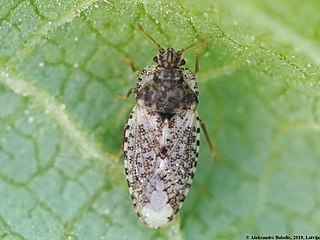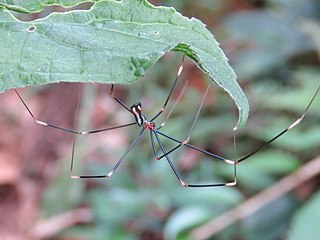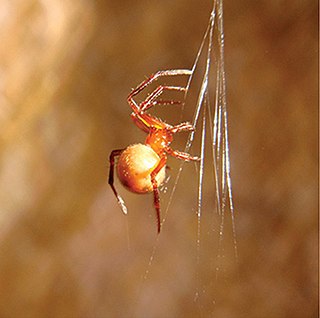
Uloboridae is a family of non-venomous spiders, known as cribellate orb weavers or hackled orb weavers. Their lack of venom glands is a secondarily evolved trait. Instead, they wrap their prey thoroughly in silk, cover it in regurgitated digestive enzymes, and then ingest the liquified body.

The Pholcidae are a family of araneomorph spiders. The family contains more than 1,800 individual species of pholcids, including those commonly known as cellar spider, daddy long-legs spider, carpenter spider, daddy long-legger, vibrating spider, gyrating spider, long daddy, and skull spider. The family, first described by Carl Ludwig Koch in 1850, is divided into 94 genera.

The Pentatomoidea are a superfamily of insects in the suborder Heteroptera of the order Hemiptera. As hemipterans, they possess a common arrangement of sucking mouthparts. The roughly 7000 species under Pentatomoidea are divided into 21 families. Among these are the stink bugs and shield bugs, jewel bugs, giant shield bugs, and burrower bugs.

Pentatomidae is a family of insects belonging to the order Hemiptera, generally called shield bugs or stink bugs. Pentatomidae is the largest family in the superfamily Pentatomoidea, and contains around 900 genera and over 4700 species. As hemipterans, the pentatomids have piercing sucking mouthparts, and most are phytophagous, including several species which are severe pests on agricultural crops. However, some species, particularly in the subfamily Asopinae, are predatory and may be considered beneficial.

The Peloridiidae or moss bugs are a family of true bugs, comprising eighteen genera and thirty-four species. They are small, ranging in length from 2 to 4 mm, rarely seen, peculiarly lumpy, flattened bugs found in Patagonia, New Zealand, eastern Australia, Lord Howe Island, and New Caledonia. Peloridiids are found amongst mosses and liverworts, commonly in association with southern beech forests. They have become known as moss bugs for their habit of feeding on mosses. Almost all Peloridiidae species are flightless, except one. Their present distribution suggests they have existed since before the breakup of Gondwana. They are the only living members of the suborder Coleorrhyncha, which first appeared in the Upper Permian, over 250 million years ago.

Nysius is a genus of false chinch bugs in the family Lygaeidae. At least 100 described species are placed in Nysius.
Mysmenopsis is a kleptoparasitic genus of tiny tropical and subtropical American spiders in the family Mysmenidae. Most live in the funnelwebs of spiders in the family Dipluridae. M. archeri lives on webs of a species in the family Pholcidae, M. capac and M. cienaga have been observed living in Cyrtophora (Araneidae) webs. One reason why diplurid webs are preferred seems to be that they are persistent in time and space, sometimes spanning several years.

Piesmatidae is a small family of true bugs, commonly called ash-grey leaf bugs. The Piesmatidae are distributed mostly in the temperate Northern Hemisphere, with some occurring in Africa, Australia and South America. A common species found throughout the Americas is Piesma cinereum.
Arachnocoris trinitatis is a true bug species found in Trinidad, West Indies. It is often found living in the webs of the pholcid spider Mesabolivar aurantiacus(Mello-Leitão, 1930). It seems to prefer empty webs, possibly utilizing them as a ready-made prey-capture device, and possibly as a site for finding mates. A. trinitatis can be found in webs all year, but is much less common during the dry season. About one quarter of M. aurantiacus webs contain at least one A. trinitatis during the wet season, with some containing two or three. When two adults are found, they are often 0.5 to 4 cm apart from each other, while keeping a distance from the host spider. They were observed to attack entangled prey, but then retreat when the spider approached it. Adults fly readily when disturbed.

Pholcus phalangioides, commonly known as the cosmopolitan cellar spider, long-bodied cellar spider or one of various types called a daddy long-legs spider, is a spider of the family Pholcidae. It is also known as the skull spider, since its cephalothorax is said to resemble a human skull. This is the only spider species described by the Swiss entomologist Johann Kaspar Füssli, who first recorded it in 1775. Its common name of "daddy long-legs" should not be confused with a different arachnid group with the same common name, the harvestman (Opiliones), or the crane flies of the superfamily Tipuloidea.

Stenolemus is a genus of thread-legged bug (Emesinae). Species of this genus are noted for preying on spiders.

Empicoris is a cosmopolitan genus of thread-legged bug (Emesinae). Numerous species have been described.

Harpactorini is a tribe of the Harpactorinae. This group is the most diverse of the entire assassin bug family, with 51 genera recognized in the Neotropical Region and 289 genera and 2003 species overall.

Caponiidae is a family of ecribellate haplogyne spiders that are unusual in a number of ways. They differ from other spiders in lacking book lungs and having the posterior median spinnerets anteriorly displaced to form a transverse row with the anterior lateral spinnerets. Most species have only two eyes, which is also unusual among spiders. A few species of Caponiidae variously have four, six or eight eyes. In some species the number of eyes will increase when the spiderling changes its skin as it grows towards adulthood.

Panjange is a genus of leaf-dwelling spiders in the family Pholcidae, widely distributed in the islands of Southeast Asia from Borneo and the Philippines to northern Australia. Panjange spiders exhibit some of the most extraordinary morphology among Pholcidae. Males of most species have eye stalks, sometimes with long pointed processes; males of some species have unusually elongated pedipalps, which in spiders function as copulatory organs; and females of some species have external portions of their genitalia strongly folded and extensible. The biological significance of these sexual modifications remain unclear.

Tachypompilus is a genus of spider wasps, found in the Neotropics Nearctic, eastern Palearctic, Indomalayan and Afrotropics.

Mesabolivar is a genus of cellar spiders that was first described by M. A. González-Sponga in 1998.

Plato is a genus of ray spider. The American biologist Jonathan A. Coddington named and circumscribed the genus in 1986. It is a Neotropical genus and it is limited to South America. As of 2018, nine species are recognized. They are found in caves and have a distinctive cubic egg sac. The generic name comes from the ancient Greek philosopher Plato.
Jo-Anne Nina Sewlal was a Trinidad and Tobago arachnologist. She discovered several new species of spiders in Trinidad and Tobago, and published some of the first surveys of spider populations in many countries of the Caribbean.
















